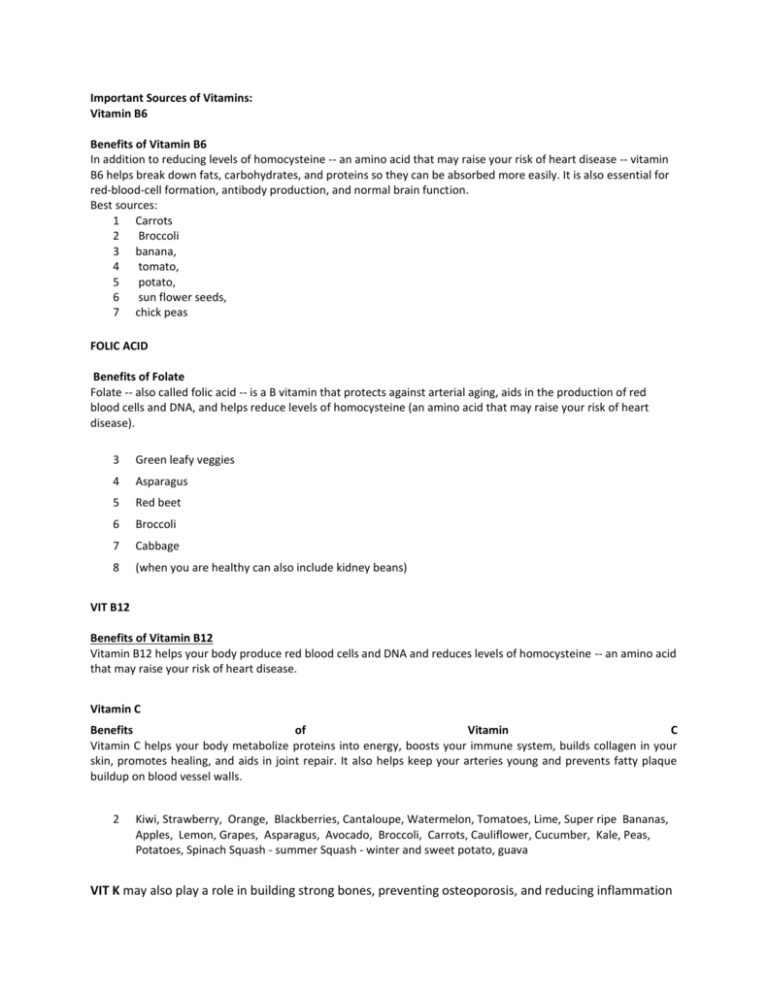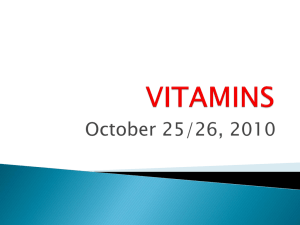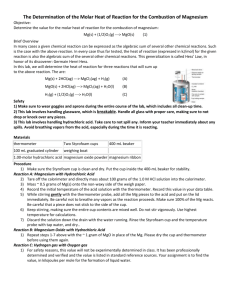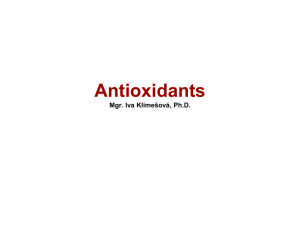Important-Sources-of-Vitamins
advertisement

Important Sources of Vitamins: Vitamin B6 Benefits of Vitamin B6 In addition to reducing levels of homocysteine -- an amino acid that may raise your risk of heart disease -- vitamin B6 helps break down fats, carbohydrates, and proteins so they can be absorbed more easily. It is also essential for red-blood-cell formation, antibody production, and normal brain function. Best sources: 1 Carrots 2 Broccoli 3 banana, 4 tomato, 5 potato, 6 sun flower seeds, 7 chick peas FOLIC ACID Benefits of Folate Folate -- also called folic acid -- is a B vitamin that protects against arterial aging, aids in the production of red blood cells and DNA, and helps reduce levels of homocysteine (an amino acid that may raise your risk of heart disease). 3 Green leafy veggies 4 Asparagus 5 Red beet 6 Broccoli 7 Cabbage 8 (when you are healthy can also include kidney beans) VIT B12 Benefits of Vitamin B12 Vitamin B12 helps your body produce red blood cells and DNA and reduces levels of homocysteine -- an amino acid that may raise your risk of heart disease. Vitamin C Benefits of Vitamin C Vitamin C helps your body metabolize proteins into energy, boosts your immune system, builds collagen in your skin, promotes healing, and aids in joint repair. It also helps keep your arteries young and prevents fatty plaque buildup on blood vessel walls. 2 Kiwi, Strawberry, Orange, Blackberries, Cantaloupe, Watermelon, Tomatoes, Lime, Super ripe Bananas, Apples, Lemon, Grapes, Asparagus, Avocado, Broccoli, Carrots, Cauliflower, Cucumber, Kale, Peas, Potatoes, Spinach Squash - summer Squash - winter and sweet potato, guava VIT K may also play a role in building strong bones, preventing osteoporosis, and reducing inflammation that leads to heart disease. Leafy green vegetables have the highest amounts of vitamin K, but other fruits and veggies have good supplies, too: Along with the green leafy vegetables mentioned earlier (especially kale, chard, mustard greens, turnip greens, and spinach), your best food sources of vitamin K include: parsley, broccoli, leaf lettuce, romaine lettuce, endive, cabbage, cauliflower, watercress, and fermented soybean products. Kale, cooked (1 cup) Spinach, cooked (1 cup) Broccoli, cooked (1 cup) Spinach, raw (1 cup) Brussels sprouts, cooked (4 sprouts) Okra, cooked (1 cup) Lettuce, romaine (1 cup) Asparagus (4 spears) Kiwifruit (1 medium) Blueberries (1 cup) 1060 mcg 888 mcg 220 mcg 150 mcg 118 mcg 64 mcg 57 mcg 30 mcg 30 mcg 28 mcg Important Sources of Minerals: BETA CAROTENE Benefits of Beta Carotene Beta carotene is a type of carotenoid found in many fruits and vegetables. You don't need beta carotene to survive, though it may help fight off certain diseases. Also, your body can convert it to vitamin A, which you do need. Good sources 1 Carrots Pumpkin and butternut squash Sweet potatoes Spinach Kale Cantaloupe Apricots Mango Nectarines Bright orange carrots, all dark green and yellow veggies and fruits CALCIUM Benefits of Calcium Calcium is essential for strong bones and teeth, and it helps prevent arthritis. But that's not all this mineral is good for. Calcium helps your brain communicate with your nerves and regulates blood pressure, and it may reduce the symptoms of PMS and the risk of colon cancer Best sources: 1 Green leafy veggies (spinach) 2 3 Soy milk Soy beans 4 Tufo 5 Broccoli, 6 spinach 7 Fruits: Oranges 8 Beans and peas 9 Miscellaneous: Sesame seeds, blackstrap molasses, almonds 10 Blackstrap molasses 2 Tbsp 400mg 11 Collard greens, cooked 1 cup 357mg of calcium 12 Soy or ricemilk, commercial calcium-fortified, plain 8 ounces 200-300 13 Turnip greens, cooked 1 cup 249 14 Kale, cooked 1 cup 179 15 Soybeans, cooked 1 cup 175 16 Okra, cooked 1 cup 172 17 Bok choy, cooked 1 cup 158 IRON Benefits of Iron One of the primary functions of iron is to pick up oxygen in the lungs and deliver it to the rest of your body. Iron is also important for DNA synthesis, which promotes growth, healing, and a strong immune system. Best sources: Spinach Kidney beans Tomatoes Lentils High in Manganese 1 Avocado, banana, blackberries, blueberries, cranberries, dates, grape fruit, pomegrate, Brussels sprouts, butternut squash, squash-winter, potato, spirulina, kale, okra, parsnip, peas and taro. MAGNESIUM Benefits of Magnesium Magnesium plays a key role in hundreds of cellular processes, from metabolizing food into energy and absorbing calcium to maintaining a strong immune system and keeping your heart, muscles, and nerves functioning properly. Good Sources of Magnesium The best sources of magnesium are the green leafy veggies . It is due to the fact that chlorophyll that imparts green color in vegetables contains magnesium. Some magnesium rich vegetables are: 1 2 3 4 5 6 7 8 9 10 11 12 Spinach artichoke any type of beans (black, kidney, navy, pinto etc) broccoli tomatoes peas cornmeal lentils potatoes okra seeds (pumpkin, squash) soybeans, and sweet potatoes. OMEGA 3 FATTY ACIDS Benefits of Omega-3 fatty acids Omega fatty acids are the good-for-you fats that protect your heart by reducing your risk for cardiovascular disease. Omega-3s also have anti-inflammatory properties that may help fight disease, boost your mind and mood, and reduce symptoms of inflammatory conditions, such as rheumatoid arthritis. BEST Sources: 1 Nuts and seeds -- and their oils -- are also good sources for omega-3s: Flaxseeds and flaxseed oil Pumpkin seeds, Walnuts, Canola oil, Olive oil POTASSIUM Benefits of Potassium Potassium helps regulate blood pressure and maintain normal heart and artery function. It also reduces the risk of stroke. Best sources: 1 Potato, 2 sweet potato 3 beets, 4 Sugar 5 Blackberries Chart: Vegetable High In Protein For 1 cup cooked Artichokes 5.9g Asparagus 5.3g Beet Greens 3.7g Beets 2.8g Broccoli 4.5g Brussels sprouts 5.5g Cabbage, green 1.5g Cabbage, red, raw 0.97g Cauliflower Mushroom Sweet corn 5.3g 3g 4g










